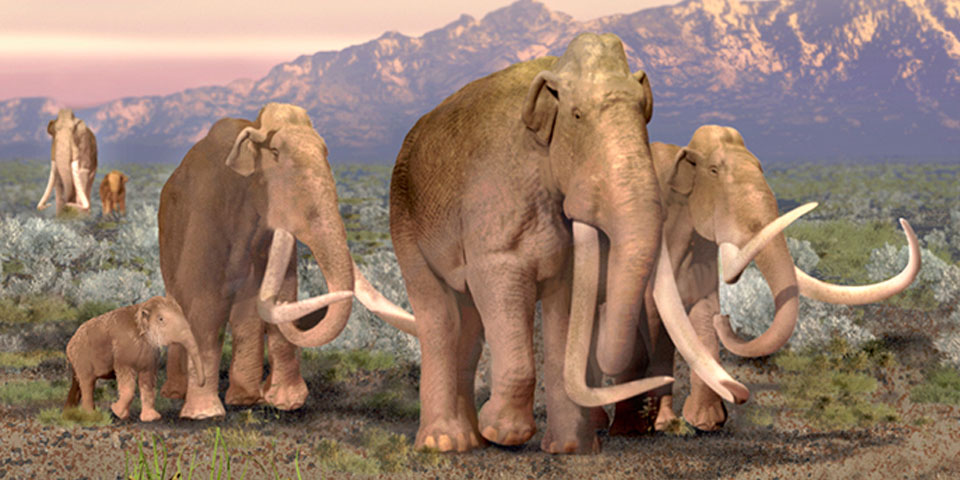While the continent of Mu was once home to many strange eldritch beings that defy human comprehension, during its period of human habitation, the local ecology wasn't unlike most tropical regions and its natural fauna was quite mundane. Cattle, goats, swine and other familiar livestock are kept on Naacal farms. Exotic birds and monkeys squawk and chatter high in rainforest canopies while reptiles, frogs, and insects scurry along the floor. Fish, whales, and dolphins swim in Mu's warm coastal waters. For the most part, there are few animals that would have been unrecognizable to modern eyes.
Of course, being a prehistoric age where many forms of now-extinct animal life existed, there are a few note-worthy exceptions. Below, in White Box (there is a reason for this) stats, are a few examples of some of the long-vanished beasts that once dwelt in this doomed land.
Naacal Mammoth (Col'hun):
Armor Class: 5 [14]
Hit Dice: 12
Attacks: 1 Trunk (Id6+2), 2 Tusk Gore (2d6), Trample (2d6+2)
Special: None
Move: 12
HDE/XP 13/2300
Larger than modern elephants, these prehistoric pachyderms are far less hirsute than their contemporary tundra-dwelling cousins. Living in large herds, wild Col'hun live mainly in the equatorial jungles and savannahs. Domesticated for the great size, strength, and surprising degree of intelligence, the Col'hun are the Naacal's primary beast of burden. Even the smallest village keeps one or two of these animals to aid with heavy work such as clearing land. Merchants also use them to pull massive carts, laden with trade goods, across the length and breadth of the continent. Many Naacal armies fight from the backs of Col'hun fitted with barding and howdahs. When treated with kindness, a domestic Col'hun can be a loyal and gentle giant. When abused or threatened, they can be deadly, near unstoppable brute.
 Terror Bird (Skal'los):
Terror Bird (Skal'los):
Armor Class: 6 [13]
Hit Dice: 3
Attacks: 2 Talons (Id6), 1 Beak (Id6+2)
Special: None Move: 18
HDE/XP 3/60
For the average Naacal, the most terrifying sound in the world is the screech of the dreaded Skal'los, a lingering species of Phorusrhacids or Terror Bird. Flocks of these giant flightless, meat-eating birds fearlessly prowl the jungles of Mu for prey—any prey. Using coordinated tactics and attacking with their massive, bone-cracking beak or kicking with their razor-sharp talons, these swift, agile birds can bring down an adult Col'hun if the opportunity arises. While their meat is inedible, the bright plumage of the males (the feathers of the female are shades of brown and gray) is prized by hunters. Also, if properly tamed and trained, they are large and strong enough for a human to ride and several Naacal kingdoms field elite units of Skal'los cavalry. Peasant levies have been known to break ranks and run when they see these armored warriors and their equally-deadly mounts charging at them.
 Smilodon (Fra'zur):
Smilodon (Fra'zur):
Armor Class: 6 [13]
Hit Dice: 7
Attacks: 2 Claws (Id6), Bite (2D6)
Special: None
Move: 12
HDE/XP 8/800
Several species of the fabled Smilodon or "Saber-Toothed Tiger" (although, these animals were not closely related to modern felines) are another ferocious predator, feared throughout Mu. Some varieties, like modern tigers or panthers, live in the jungles, waiting in trees or cliffs to pounce upon unsuspecting prey. Other species live in the grasslands and mountainous region in prides like lions. Along with slashing attacks from their massive claws, their long incisors and powerful jaws make the Fra'zur an especially dangerous threat.
These are just some of the unique, prehistoric creatures that you're characters can encounter. Have suggestions for more? Post them in the comments below.


